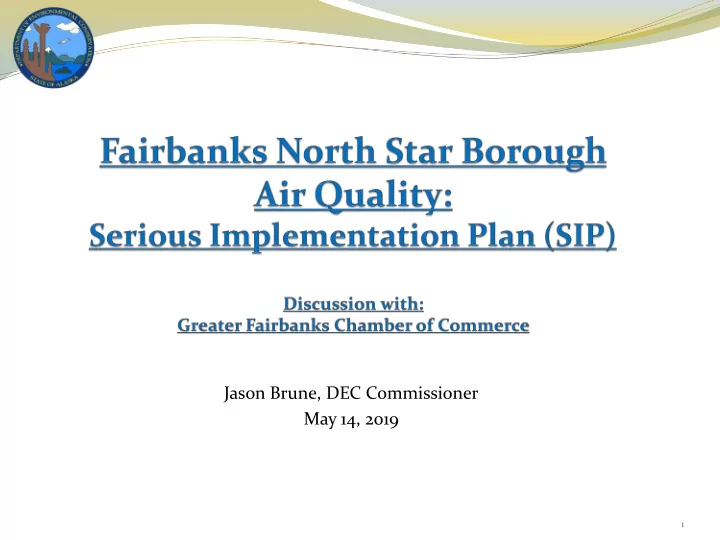

Jason Brune, DEC Commissioner May 14, 2019 1
Overview What is PM2.5 and Why Are We Here? Current Air Quality Trends When can the area attain? Key Goals and Elements of SIP Summary of Control Measures Public Review Timeline How to Comment 2
Particulate Matter: What is it? A complex mixture of extremely small particles and liquid droplets. Hair cross section (70 µm) Source: M. Lipsett, California Office of Environmental Health Hazard Assessment 3
4
Public Health Risks Are Significant Particles are linked to: Premature death from heart and lung disease Aggravation of heart and lung diseases Hospital admissions Doctor and ER visits Medication use School and work absences And possibly to Lung cancer deaths Infant mortality Developmental problems in children, such as low birth weight Some groups are more at risk: People with heart or lung disease Older adults Children 5
Fairbanks North Star Borough PM2.5 Nonattainment Where are we at? Serious nonattainment area Public health concerns Goal is to have healthy air to breathe Federal planning requirements Initial control plan is being implemented Reclassification to Serious area means a new plan must be developed Sanctions are imposed for state failure to act Serious plan requires more controls to bring area into compliance 6
What Happens if We Don’t Take Action? Do Not Submit Submit SIP A SIP Complete/Adequate EPA will file a • Incomplete/Inadequate “Failure to Submit” EPA has 6 months Sanction clock • • EPA identifies • to determine started inadequacies completeness 18 months later • Sanction clock • EPA begins sanctions in effect • started process to Federal • 18 months to • approve SIP Implementation update Serious SIP Committed Plan start soon • for deficiencies measures in SIP after implemented Federal Plan State Plan 7
Progress is Being Made - Air Monitoring Trend 8
Current Air Quality Air monitoring trends show great improvement More pollution reduction needed to reach a Design Value of 35 micrograms per cubic meter (ug/m 3 ) across the entire area Air Monitoring Site Year: 2012 2013 2014 2015 2016 2017 2018 3-Year Design Value State Office Building 46 41 40 35 37 38 35 Ncore 45 40 39 35 33 34 30 North Pole Hurst Rd 139 124 106 85 65 9
When can the area attain the PM2.5 standard? Serious Plan cannot demonstrate attainment in 2019 Plan shows that the area will realistically be able to reach attainment in the timeframe between 2024 and 2029. 10
Key Goals and Elements of the Serious SIP Show how the area can reach attainment Continue to allow the use of solid fuel fired devices Limit the impact on large industrial sources as they are not the main contributors of the problem Meet the EPA completeness criteria for a SIP (avoid sanction) Meet the Best Available Control Measure (BACM) and Best Available Control Technology (BACT) Requirements Are proposed controls technically and economically feasible? Position the SIP and control measures for transition to a 5% Plan, the next SIP update needed 11
Summary of Control Measures Proposed control measures build off existing/continuing controls and Stakeholder recommendations Required to look at measures from across the nation Timing of proposed controls varies to allow time to prepare and plan Seeking comment on controls including timing, technical and economic impacts Suite of updated requirements related to solid fuel heating devices New stove standards (cleaner burning), change-out requirements, dry wood sales, stove registration for certain programs 2-Stage solid fuel burning curtailments remain in place with new thresholds and an updated waiver program. Retrofit Electrostatic Precipitators (ESPs) are not mandated but are included as a technology that needs more study 12
Summary of Control Measures (cont) Proposing a switch to Diesel #1 for space heating in the nonattainment area in 2020 Small commercial sources Charbroilers, incinerators, used oil burners – Will request information Coffee roasters – Control or show technical/economic infeasibility within one year Individual BACT determinations for large industrial sources 13
Proposed BACT Determination Highlights Highlights of BACT Controls by Pollutant Pollutant Aurora Fort Wainwright GVEA North Pole GVEA Zehnder UAF Fine Particulate Existing Existing Existing Existing Existing Matter (PM.25) – No new control No new control No new control No new control No new control Direct Volatile Organic Existing Existing Existing Existing Existing Compounds No new control No new control No new control No new control No new control (VOC)s No new control No new control No new control No new control No new control Nitrogen Oxides Precursor Precursor Precursor Precursor Precursor (NOx) Determination Determination Determination Determination Determination No controls No controls No controls No controls No controls Ammonia (NH3) available available available available available NEPA process to Short-term: fuel Economically determine either switch to Diesel #1 infeasible, fuel Economically during curtailments switch to ULSD in SO2 control on infeasible Owner requested existing facility or Long-term: ULSD emergency Sulfur Dioxide limit to lower replace facility or Natural Gas once generators emissions below (SO2) Use low sulfur coal decision on 0.2% S by weight by BACT threshold Use low sulfur coal utilization of Healy Use low sulfur coal 2021 1 & Healy 2 finalized 0.2% S by weight by 0.2% S by weight by 2021 around 2022. 2021 14
Serious SIP Available for Public Review & Comment May 14 - Start public comment period May 16 - Presentation to FNSB Assembly 5:30 PM June 25 - Open House at Westmark Hotel 6-8 PM June 26 – Hearings at FNSB Assembly Chambers 12- 1:30 PM and 5-8 PM July 26 – End comment period 15
How to Comment DEC wants your feedback Comments are important to finalizing the plan Several ways to submit comments: Electronically - online form Email Mail Public Hearing Handout with details on how to comment is provided in the back of the room. 16
Questions? Thank You! 17
Recommend
More recommend